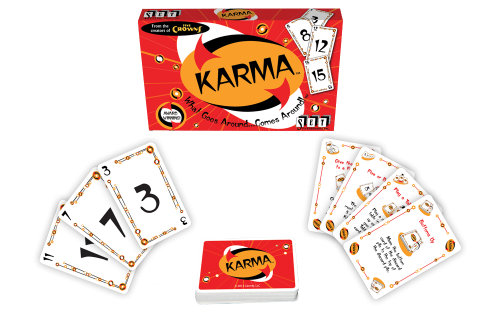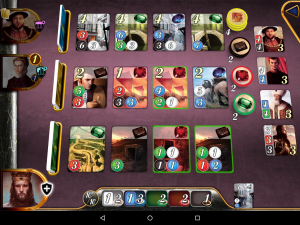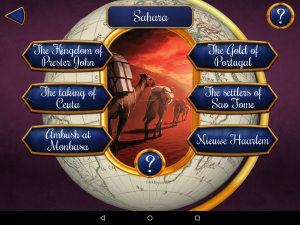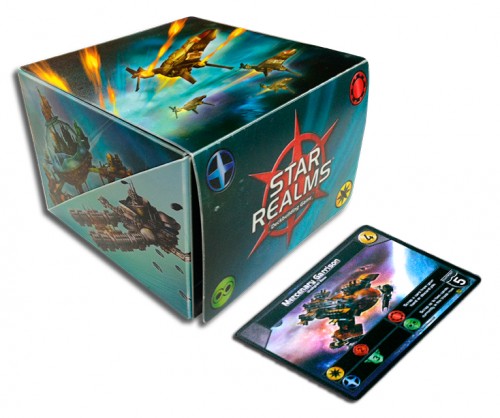With Karma, from Set Enterprises, you get a deck of cards numbered 1-16 three times—plus 12 special “Karma” cards. The goal is to get rid of all your cards by dropping on to the discard pile a card that’s equal-to or greater than the card placed by the last player. If you can’t play up, as it were, the whole discard pile becomes yours.
It’s a basic style of gameplay that you’ve probably experienced before. What Karma adds to that, though, includes:
- A set of three face-down and three face-up “table cards” for each player. These are also cards you must get rid of in order to go “out” but which you can’t in general play until your hand is empty.
- The ability to play multiple cards. That is, on the same turn you can play two or three of the same card as a way of emptying your hand faster. Additionally, whether they’ve been played by just one or multiple players, whenever three of the same cards are on the top of the discard pile, that whole pile is taken out of the game.
- Karma cards, which when played allow you to do special things like play one of your table cards early or force another player to just take the discard pile out-of-turn.
All together, this makes for a serviceable light, social card game if that’s what you’re looking for. Play is rapid. Decisions are easy. The game has a take-that element. And the relative fortunes of players can reverse quickly.
Personally, however I don’t particularly enjoy Karma. Whether it usually goes that way or not, Karma feels like a game that could last forever. The fewer cards you have in your hand, the more likely it will be that you’ll have to take the discard pile. Even when you get down to your last three table cards, those are the face-down ones, which you have to play without looking. If the one you play is a lower number than the last played card, there you are starting over with a full hand. When I played, I actually found myself intentionally saving up and laying down triples just to move the game along.
Another thing that bothers me a little about Karma is the way the game defines winners and losers. According to the rules, you keep playing until all but one person has gotten rid of all their cards. All those people are winners. The one player left with cards is the loser. It’s not a big deal for a group of adults. However, it seems to me not an especially nice way to end a social card game by declaring one lone loser.
A complimentary copy of Karma was provided by Set Enterprises for review.
- Comments Off on Second Look—Karma

I’ve taken a look at a few RPGs for Purple Pawn. Some descent ones. Some pretty bad ones. So far I haven’t really read any great ones.
Along comes Dungeon World, and RPG I first saw at PAX East. A smaller book clustered in with a lot of other smaller RPGs. It looked pretty interesting, but I didn’t give it much extra thought. As I was going through my post-con follow ups I shot the designers and email asking if they’d like a review done. They happily provided digital copies of the book, including a Kindle version. Wow. That’s pretty cool. The file was formatted professionally, and it made reading an electronic version of the book so much easier than having to do it on my laptop, phone or tablet screen.
It only took a few pages for me to get hooked, the only thing stopping me from blasting through the whole book at once was time.
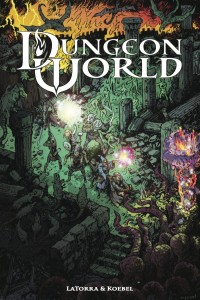 The system seemed simple. The book laid out and presented in such a way that the information was easy to understand and read through without problem. Dungeon World was actually enjoyable to read!
The system seemed simple. The book laid out and presented in such a way that the information was easy to understand and read through without problem. Dungeon World was actually enjoyable to read!
The system is made up of moves, both for the GM and the player. Character creation is minimal, and die rolls are done on 2d6 with the exception of damage. Dungeon World as a whole is a toolkit for telling an excellent fiction without too much getting in the way, but just enough to keep the players interested with their actions and die rolls. The GM also relies heavily on the players for world building. The goal is to be able to sit down and play without too much prep getting in the way and spoiling the fun.
There’s plenty more detail I could go into, but really you should just snag the game for yourself. It’s worth a read, and most certainly worth a play. I’m already getting a campaign ready for my kids to play. It’s that easy. You can snag the digital copy for $10, or a print copy for $25.
A review copy of Dungeon World was provided free for review by Sage Kobold Productions.
Second Look: CPU Wars Volume 2.0: Battle of the Servers
29 Jul
Posted by Lory Gilpatric as Card Games
 A few years ago, a tech professional created a simple card game where players try to beat each other’s hands by having a card with the highest value. The part that made CPU Wars Volume 1.0 unique was the fact that the cards were all pictures and specs of computer processor chips.
A few years ago, a tech professional created a simple card game where players try to beat each other’s hands by having a card with the highest value. The part that made CPU Wars Volume 1.0 unique was the fact that the cards were all pictures and specs of computer processor chips.
The game was popular enough to spawn a stand-alone sequel. CPU Wars Volume 2.0 covers 30 CPUs that focus on the history of servers dating back across the past 40 years. The game can be played by itself, or combined with CPU Wars Volume 1.0 for extended play (and more players).
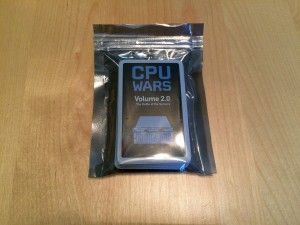 Two tech-savvy friends played CPU Wars 2.0 with me and were immediately giddy over the game’s packaging, which is an anti-static sealed bag. They also enjoyed reminiscing over the status of some of the older computer companies, like SPARC and Sun Microsystems.
Two tech-savvy friends played CPU Wars 2.0 with me and were immediately giddy over the game’s packaging, which is an anti-static sealed bag. They also enjoyed reminiscing over the status of some of the older computer companies, like SPARC and Sun Microsystems.
I know a thing or two about computers, but feel like I’m reading a different language when it comes to the details of processor chip specifications. However, I could still play this game just as good as my opponents.
The game supports two to three players. All cards are divided evenly amongst the players and each player picks one card from the top of their deck. The active player picks a category from the list on the card (like Max Clock Speed, or Die Size). Everyone then reads the value listed on their own card for that category. The player with the highest or lowest number wins. Whether high or low wins is designated by an up or down arrow next to the category.
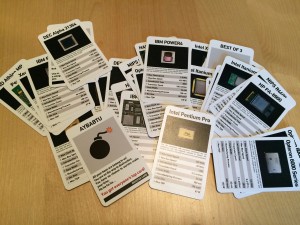 You can also play an alternate version of the game where a D8 dice is rolled and the category is chosen at random. I highly recommend playing this version, since it adds an element of chaos to the gameplay.
You can also play an alternate version of the game where a D8 dice is rolled and the category is chosen at random. I highly recommend playing this version, since it adds an element of chaos to the gameplay.
You don’t have to know a thing about computers to play the game. All you have to do is choose a category and hope your number is higher (or lower) than your opponents’.
From a gamer’s perspective, the rules are a little too vague, which can be frustrating. The game is also a little unbalanced, especially if your card is from a few decades ago. Older processors have lower numbers for nearly every category except Introduction Year and Max TDP. Additionally, just like the traditional card game, War, this can last hours because a player may be down to only a few cards and suddenly end up with most of the deck after just a few rounds. We ended up just stopping after about 20 minutes.
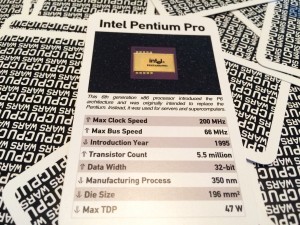 Overall, we enjoyed how easy it was to simply sit down and play the game. It would make the perfect stocking stuffer for your hardware engineer friend or as a secret Santa gift for anyone working in the tech industry.
Overall, we enjoyed how easy it was to simply sit down and play the game. It would make the perfect stocking stuffer for your hardware engineer friend or as a secret Santa gift for anyone working in the tech industry.
You can pick up each volume for only $10 or the double-pack for $17. You also can really make your computer tech buddy happy with an actual electrostatic-sensitive device component gift box.
- Comments Off on Second Look: CPU Wars Volume 2.0: Battle of the Servers
 I’ve been waiting for my copy of Chew: Cases of the FDA to come to my local comic book shop for half-a-year. It finally arrived last week and I was able to play the game with two friends this past weekend. It is a crime-solving card game based on the popular comic book by the same name. Players find clues, partners, and other characters through a series of investigations that lead to tracking down the culprit.
I’ve been waiting for my copy of Chew: Cases of the FDA to come to my local comic book shop for half-a-year. It finally arrived last week and I was able to play the game with two friends this past weekend. It is a crime-solving card game based on the popular comic book by the same name. Players find clues, partners, and other characters through a series of investigations that lead to tracking down the culprit.
The goal of the game is to create a path from your Case card to your Culprit card by connecting them through a series of clues that match by color. Clues are earned after playing investigation cards.
Each player is dealt one Case and one Culprit, plus five investigation cards and three “Chogs” to start. A Chog is half-chicken, half-frog and is used as payment to play investigation cards.
On your turn, you start by picking up investigation cards and Chogs. Investigation cards help you do things like, take an extra Clue card or double your Chog supply. There are Partner cards, which give you various bonuses. Bad Guy and Pain-in-the-@$$ cards are used against your opponents.
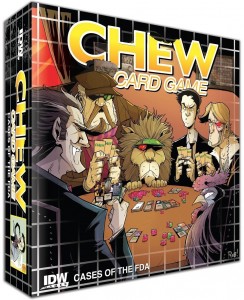 After playing investigation cards, players choose a Connection from four available Clue cards laid out in the center of the table. Your Clue cards must match each other on one side. So, if your Case card has a red right side, the Clue card you put next to it must have a red left side. The only exception is a wild card board, which allows you to use any color. Clue cards have a point value, which is used to determine your score.
After playing investigation cards, players choose a Connection from four available Clue cards laid out in the center of the table. Your Clue cards must match each other on one side. So, if your Case card has a red right side, the Clue card you put next to it must have a red left side. The only exception is a wild card board, which allows you to use any color. Clue cards have a point value, which is used to determine your score.
The game ends when a player creates a path with at least 20 Clue card points that also matches from the Case to the Culprit card. One game takes about 30 minutes to play.
The game is designed to be very simple. Investigation cards have specific actions on them that are easy to understand.
My friends and I really enjoyed this game for its simplicity and humorous content. One friend has never read the comic and commented on how he thought the flavor text was very funny and the artwork was appealing. He is planning on buying the Chew comic in order to find out more about the unusual story.
This game is great for casual gamers looking for a light, fun experience. Even heavy gamers can enjoy this title as an in-between snack. While the game is fun and easy to understand, it isn’t exactly family-friendly, depending on the age of your children. There are a few swear words and cartoonish violent imagery. Plus, it might be difficult to explain to a five-year-old why the game’s protagonist has to eat human flesh in order to solve a crime.
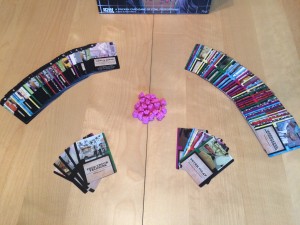
You can pick up Chew: Cases of the FDA from your local board game shop (or even comic book shop) for about $30.
- Comments Off on Second Look – Chew: Cases of the FDA
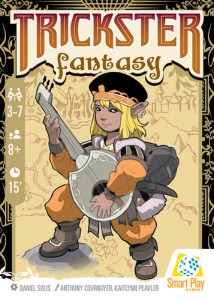 Daniel Solis has a really strong track record in my opinion. I’ve enjoyed every game I’ve played of his over the years, and Trickster is no exception. For those unfamiliar, Trickster is a trick playing series of card games that share core rules, but have different themes and special card powers. I’ve played the two current decks, Fantasy and Tianxia. Fantasy is kind of the introductory deck, with simple card powers and colorful fantasy characters. Tianxia contains powers that require a bit more thought with their use, but add an awesome new flavor to play. The cool part? You can mix and match between decks.
Daniel Solis has a really strong track record in my opinion. I’ve enjoyed every game I’ve played of his over the years, and Trickster is no exception. For those unfamiliar, Trickster is a trick playing series of card games that share core rules, but have different themes and special card powers. I’ve played the two current decks, Fantasy and Tianxia. Fantasy is kind of the introductory deck, with simple card powers and colorful fantasy characters. Tianxia contains powers that require a bit more thought with their use, but add an awesome new flavor to play. The cool part? You can mix and match between decks.
Core gameplay is simple. Each round has a leader and a trickster that dictate how the other players need to play their cards. All card powers are resolved when that card is played. Each player follows by playing a card that follows the rules set by the leader and trickster. If a player can’t then they have to take the pot of cards into their house. If each player can play a card, then the trickster takes the pot. Whoever ends up with the pot becomes the leader for the next round.
Game play continues until a player has no more cards in their hand (this condition may change depending on the number of players.) Then cards in the house are counted up, and the winner is the player with the least amount in their house. There’s two things to remember here. A player with cards still in their hand must place them in their house before scoring. Also, the player with the most cards of a suit doesn’t have to score those cards.
It seems very simple, but it’s the card powers that make the game really shine.
I’ve played both Fantasy and Tianxia with my kids (5, 8, and 10) and they all really enjoyed them. My 5 year old took a bit more time to learn the powers, but now knows each in the Fantasy deck by the icons on the cards. The Tianxia deck is still a bit much for him, though he hasn’t given up on it yet!
Daniel has 2 more decks on the way, Starship and Symbiosis. I’ve had a look at the print-and-play playtest decks, and they’re looking really good. I haven’t had a chance to try them out just yet, but I’m eagerly awaiting a chance to do so.
Both decks are an excellent deal. Fantasy is normally $15, but is currently $6.74. Tianxia is normally $12, but is also currently $6.74. My recommendation would be to head over to DriveThruCards right now and snag both.
A copy of Trickster: Tianxia was provided free for review by Smart Play Games. A copy of Trickster: Fantasy was purchased on my own for review.
- Comments Off on Second Look—Trickster Fantasy and Tianxia
Second Look—Splendor for Mobile
09 Jul
Posted by David Miller as Electronic Games, Modern Board Games
![]() The Splendor mobile app launches today on Android and iOS devices. Put out by Days of Wonder, the game offers two types of play. One is a faithful adaptation of the tabletop game and can be played against the computer or in pass-and-play mode. The other, called “Challenges”, is more of a solitaire puzzle experience.
The Splendor mobile app launches today on Android and iOS devices. Put out by Days of Wonder, the game offers two types of play. One is a faithful adaptation of the tabletop game and can be played against the computer or in pass-and-play mode. The other, called “Challenges”, is more of a solitaire puzzle experience.
Both have me hooked!
What’s the game like?
 For those not familiar with this recent cardboard hit, Splendor supposedly has players developing their Renaissance merchant houses to earn prestige and recognition from the nobles. Really though, the theme is pretty thin. The gameplay however, while quite simple, presents some very interesting strategic challenges.
For those not familiar with this recent cardboard hit, Splendor supposedly has players developing their Renaissance merchant houses to earn prestige and recognition from the nobles. Really though, the theme is pretty thin. The gameplay however, while quite simple, presents some very interesting strategic challenges.
On each turn, a player can either take gemstone chips (available in limited quantities in five colors) or spend previously collected chips to purchase a development card from those on display. Every card provides a permanent bonus in one color, making it easier to purchase additional cards in subsequent turns. Some cards also provide victory points.
The cards are laid out four-to-a-row in three rows. As you go from the bottom row to the middle to the top, the cards get more expensive but are also more likely to provide more victory points.
A group of noble tokens work essentially like achievements. The first person to collect the number and color of cards indicated on each token gets certain bonus points.
Game-end is triggered when someone hits 15 victory points, and of course the player with the most points is the winner.
How does the app play?
The mobile app works exactly the same way. The screen resembles a normal tabletop setup, with art derived from the physical version. And the usual digital options are provided: choice of avatars, volume control for background music, etc.
The only thing that Splendor doesn’t currently do is live online play. Instead, there’s pass-and-play and a choice of five computer opponents. These aren’t rated by difficulty level but rather by style of play: balanced, specialized, opportunistic, random behavior, and secret behavior. I haven’t tried them all yet but those I did I found to be worthy adversaries.
Days of Wonder promises to add an online multiplayer mode in a future update. In the meantime, players have the option to post scores to an online leaderboard.
What are Challenges?
Challenges are solitaire puzzle-like scenarios. With challenges, the basic method of play remains unchanged, though the specific parameters—for example, the number of chips collected per turn or the point value of various cards—may be different. In some cases, the goal is to hit a set number of victory points within a certain number of turns. In others it’s winning a specific card or collecting a particular combination of bonuses.
There are three sets of six challenges included with the base game, each associated with a center of trade from the 15th or 16th century.
Again, I haven’t played through all of them but those I did were, well, challenging. For most too, the cards that come out are still random. Thus even a completed challenge may be interesting to play again.
Where can I get it?
For its $6.99 price, digital Splendor is a good deal. The quality of the tabletop-to-mobile adaptation is first-rate.
If there’s one thing to quibble with it would be with the way the Challenge parameters are explained and displayed. For example, it took me a few minutes to figure out that in describing a Challenge, “value of Prestige Points” means the number of points needed to win. But once that was resolved, it certainly didn’t present any ongoing barrier to play. Nor did I find any such issues with the basic gameplay tutorial.
The underlying game too is much more than one of those mindless time-wasters. Yet it’s not so complex that it requires some high-level dedication to learn or play reasonably well. For me at least, that’s the sweet spot. I suspect I’ll be playing this one a lot.
Click here to purchase Splendor for iOS devices via iTunes.
Click here to purchase Splendor for Android devices via the Google Play store.
A complimentary copy of digital Splendor was provided by Days of Wonder for review.
- Comments Off on Second Look—Splendor for Mobile
 Spy Alley Partners LLP contacted me shortly after Toy Fair this year and offered to send me their Spy Alley family of games to review. The games, Spy Alley, Spy Alley Junior, and the Spy Alley Dice Game, all have the same theme of trying to guess the hidden identity of the other players before yours is figured out. Each game is exceedingly simple to play, and in my opinion, a bit boring. The worst of all being the Spy Alley Dice game, which almost feels broken.
Spy Alley Partners LLP contacted me shortly after Toy Fair this year and offered to send me their Spy Alley family of games to review. The games, Spy Alley, Spy Alley Junior, and the Spy Alley Dice Game, all have the same theme of trying to guess the hidden identity of the other players before yours is figured out. Each game is exceedingly simple to play, and in my opinion, a bit boring. The worst of all being the Spy Alley Dice game, which almost feels broken.
Not wanted to pass judgement before giving the games their due, I made sure to play with each of my kids (minus the baby, of course) to see how they liked each one. 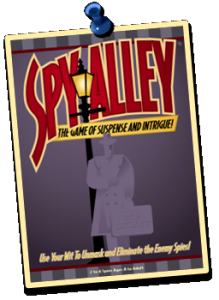 Spy Alley was worth a few minutes of fun with them, but they really disliked Spy Alley Junior and the Dice Game, saying that the original game was easy enough as it was. It wasn’t long before they were asking for different games to play.
Spy Alley was worth a few minutes of fun with them, but they really disliked Spy Alley Junior and the Dice Game, saying that the original game was easy enough as it was. It wasn’t long before they were asking for different games to play.
To be fair, these games are targeted to a more mass market audience, and my children have grown up playing just about everything that’s come across our doorstep. Then again, there’s plenty of mass market targeted games that they really enjoy.
There’s really not much more I can say about these games than I recommend you steer clear of them. There’s better stuff out there to spend your money on.
Copies of each title were provided free for review by Spy Alley Partners LLP.
- Comments Off on Second Look—Spy Alley Family of Games
 Another great game in a yellow box.
Another great game in a yellow box.
Of course I almost didn’t realize it. I almost came here to write a negative review of the game. That initial thought came from a late night game session with my five-year-old while we were packing before moving to a new house. It was late, we were both tired, and it turns out we played the game very wrong.
Fast forward a bit. We’re in the new house, and now my other 2 older kids and the five-year-old want to play. I grumble, but accept. I re-read the rules. Oh man. I played this wrong the last time! We then managed to have a very enjoyable 15-20 minutes playing a 4-player game.
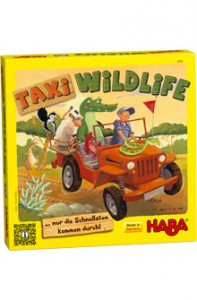 In Taxi Wildlife you’re trying to get the most route cards and animals. You do this by drawing duel cards and trying to snatch an animal blindly out of a bag with one hand. The animal needs to match one of the 3 route cards currently on the table. Match the animal, get the card. Of course the card also need to match on of the ends of your existing route, or it can’t be played. Also, if the actual animal is on the card (not just the picture on the sign) then you get to take it instead of putting it back in the bag. This further complicates things for other players since there’s only 2 of each animal in each bag.
In Taxi Wildlife you’re trying to get the most route cards and animals. You do this by drawing duel cards and trying to snatch an animal blindly out of a bag with one hand. The animal needs to match one of the 3 route cards currently on the table. Match the animal, get the card. Of course the card also need to match on of the ends of your existing route, or it can’t be played. Also, if the actual animal is on the card (not just the picture on the sign) then you get to take it instead of putting it back in the bag. This further complicates things for other players since there’s only 2 of each animal in each bag.
It’s fast paced, super easy, and a lot of fun to go digging around the bags for animals. You play through the duel deck 4 times, then count up each players’ route cards and animals to determine the winner.
Overall this is a big thumbs up, and can be played with the whole family. It actually may be my new favorite HABA game.
A copy of Taxi Wildlife was provided free for review by HABA.
- Comments Off on Second Look—Taxi Wildlife
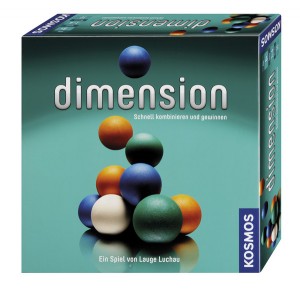
I was really excited when Kosmos reached out to me and offered to send a game to review. With the current lineup that I saw at Toy Fair, my mind was buzzing with what game they were going to send me. When I received Dimension I thought, “OK. Not what I would have chosen, but at least I haven’t played it before.”
I kind of wish I didn’t play it at all.
As a puzzle game, it’s not too bad. That’s all there is to it. It’s multiplayer solitaire, and I’m just not a fan of this type of game. Cards are drawn which dictate the rules to how your colored balls have to be placed, and you have a specific amount of time to stack them and follow the rules. Points are scored based on now well you follow the rules, and the amount of balls you use.
Overall it just felt kind of flat as a multiplayer game, though it kept my kids busy when I set out a set of cards and set them to the task by themselves.
I’ve found the game for around $30 at it’s cheapest online, and I’m not sure if its really worth that price.
A copy of Dimension was provided free for review by Kosmos.
- Comments Off on Second Look—Dimension
 Legion Supplies just recently sent over some card sleeves, a deck box, and a flip box for Star Realms. I sleeved some cards, stored a deck, and finally got rid of the already-splitting Star Realms box I was currently using. My thoughts below:
Legion Supplies just recently sent over some card sleeves, a deck box, and a flip box for Star Realms. I sleeved some cards, stored a deck, and finally got rid of the already-splitting Star Realms box I was currently using. My thoughts below:
Card Sleeves: These card sleeves are tough! They feel a bit thicker than ones from Ultra Pro or BCW, and the printing on them is beautifully done. The sleeves I used had the “Bad Beats” artwork on them, which my kids thought was hilarious. My only gripe is that my cards don’t fit as snugly in these as they do in the previously two mentioned brands. Sometimes during play the cards would shift a bit and start to come out of the top of the sleeve. It’s not a deal breaker, though. They do cost quite a bit more than other sleeves. $4.50 to $5 for 50. At first I thought it was just for the printed sleeves, but plain color ones were just as much.
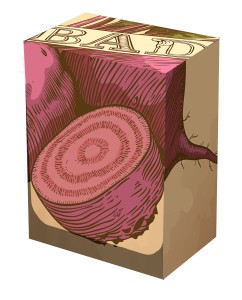 Deck Box: The deck box also had the “Bad Beats” printing. Unfortunately I lost this case to my son, who claimed that since I already had a BCW Deck Locker, that he wanted it. It’s a shame, too, because it’s one of the nicest deck boxes I’ve used. Durable, with a Velcro flap and a divider inside. For $3.50, these are a no brainer. If you’re looking for a standard deck box, these are the ones to go with.
Deck Box: The deck box also had the “Bad Beats” printing. Unfortunately I lost this case to my son, who claimed that since I already had a BCW Deck Locker, that he wanted it. It’s a shame, too, because it’s one of the nicest deck boxes I’ve used. Durable, with a Velcro flap and a divider inside. For $3.50, these are a no brainer. If you’re looking for a standard deck box, these are the ones to go with.
Star Realms Box: A specialized product meant for keeping your Star Realms stuff safe, this box has two compartments and the flap seals with Velcro. It’ll hold every Star Realms card released to date, even if sleeved. It even comes with a promo card for the game! If you play Star Realms, you know how hard it is to get your cards in and out of the box they came in. It’s a VERY tight fit, even when the cards are brand new. This case is $10, but worth every penny to keep the game in safe, and in one place. Legion has a bigger box for $20 that comes with 224 sleeves, 4 promo cards, and dividers, too. I may be snagging that one soon.
Card sleeves, deck box, and Star Realms box were all provided free for review by Legion Supplies.
- Comments Off on Second Look—Legion Supplies
Trending
- Home
- Vintage Return of the Jedi: Play-for-Power Card Game is easier to find than the original cut of the movie
- Master Malaysia, Designed by Committee
- The 20 Most Valuable Vintage Board Games
- The Truth About Dominoes On Sunday in Alabama
- MayDay Games Slammed Over Handling of Crokinole Board Problems
- Baila, the Estonian Drinking Card Game
- Fairy Crystal Forest
- The Berkhamsted Board Game
- Dapper Devil Accessories
Archives
Most Popular Articles
- The 20 Most Valuable Vintage Board Games
- Sequence Game, and Variants
- Baila, the Estonian Drinking Card Game
- USPS Adds Board Game Flat Rate Box
- The 13 Most Popular Dice Games
- The Truth About Dominoes On Sunday in Alabama
- Are Board Games Dangerous?
- Oh the Irony—Illuminati Card Game Continues to Inspire Conspiracy Theorists
- The Convoluted Story of Iron Wind Metals, Ral Partha, and Battletech Miniatures
- Guess Who? The Naked Version
Recent Posts
- Toy Fair 2019—Breaking Games
- Talisman Kingdom Hearts Edition
- Toy Fair 2019—Winning Moves
- Toy Fair 2019—Games Workshop
- Toy Fair 2019—Star Wars Lightsaber Academy
- Toy Fair 2019—Stranger Things Games
- Toy Fair 2019—HABA
- Licensing Roundup
- Game Bandit
- 2018 A Difficult Year For Hasbro But Not For D&D Or MtG
Recent Comments
- on Toy Fair 2019—Winning Moves
- on Game Bandit
- on Second Look—Dungeons & Dragons Waterdeep Dragon Heist
- on Crowdfunding Highlights
- on Beyblade SlingShock
- on Game Bandit
- on Game Bandit
- on Watch This Game!, the Board Game Review Board Game
- on Second Look—Vampire: The Masquerade 5th Edition
- on Palladium Books Loses Robotech IP License, Cancels Five-Year-Overdue Robotech RPG Tactics Kickstarter

